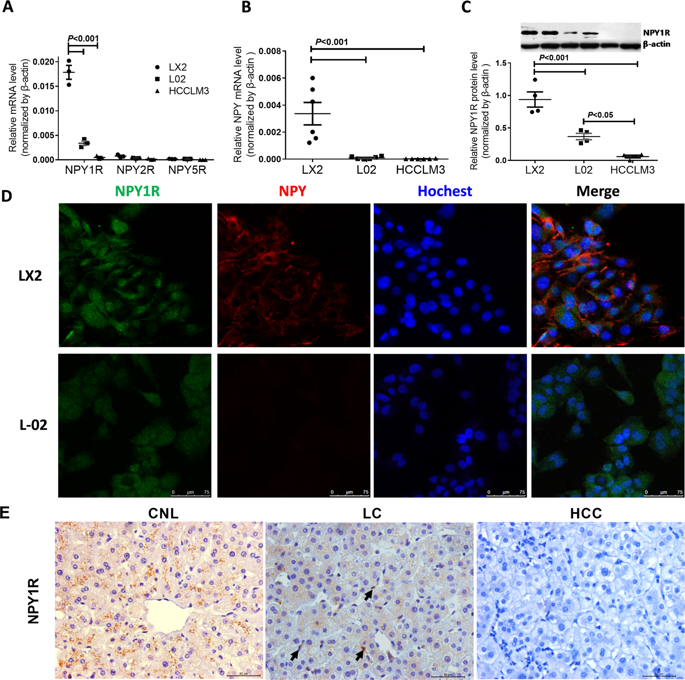Scientific Reports ( IF 3.8 ) Pub Date : 2019-07-01 , DOI: 10.1038/s41598-019-45932-3 Wufei Dai 1 , Yang Liu 1 , Yali Zhang 2 , Yufeng Sun 1 , Changjiang Sun 3 , Yu Zhang 4 , Xiufang Lv 1

|
Neuropeptide Y (NPY) is an abundant neuropeptide in the mammalian central and peripheral nervous systems. Transgenic mice overexpressing NPY in noradrenergic neurons have increased level of hepatic triglycerides, fatty acids and cholesterol, which contributed to the development of hepatosteatosis. However, the roles of NPY in the activation of hepatic stellate cells (HSCs) and the underlying mechanisms remain unclear. This study aimed to investigate the expression and secretion of NPY in human immortalized HSC LX-2 cells and the regulatory function of NPY on the fibrogenic response in LX-2 cells, to explore the potential association between NPY and LX-2 activation. The results showed an increase in the expression and secretion of NPY(1–36) in activated LX-2 cells. Both endogenous and exogenous NPY(1–36) induced the phosphorylation of mTOR, p70S6K, and 4EBP1 and promoted the fibrogenic response via NPY Y1 receptor subtype (NPY1R), as these responses were blocked by either an NPY1R antagonist (BIBP3226) or NPY1R knockdown. Moreover, NPY(1–36) serum levels were increased in patients with liver cirrhosis (LC) and hepatocellular carcinoma (HCC) and presented a positive relationship with MELD scores in LC patients. These findings suggest that immortalized HSCs LX-2 have the potential to produce NPY(1–36). High serum levels of NPY(1–36) is correlated with hepatic dysfunction in cirrhotic patients.
中文翻译:

在激活的人HSC细胞系中神经肽Y的表达增加。
神经肽Y(NPY)是哺乳动物中枢和周围神经系统中的一种丰富的神经肽。在去甲肾上腺素能神经元中过表达NPY的转基因小鼠的肝甘油三酸酯,脂肪酸和胆固醇水平升高,从而导致肝硬皮病的发展。但是,NPY在肝星状细胞(HSC)激活中的作用及其潜在机制仍不清楚。这项研究旨在调查NPY在人类永生化的HSC LX-2细胞中的表达和分泌以及NPY对LX-2细胞中纤维化反应的调控功能,以探讨NPY与LX-2活化之间的潜在联系。结果显示,活化的LX-2细胞中NPY(1-36)的表达和分泌增加。内源性和外源性NPY(1-36)均可诱导mTOR,p70S6K,和4EBP1并通过NPY Y1受体亚型(NPY1R)促进了纤维化反应,因为这些反应被NPY1R拮抗剂(BIBP3226)或NPY1R敲低所阻断。此外,肝硬化(LC)和肝细胞癌(HCC)患者的NPY(1-36)血清水平升高,并且与LC患者的MELD得分呈正相关。这些发现表明,永生的HSCs LX-2具有产生NPY(1-36)的潜力。肝硬化患者的血清NPY(1-36)高水平与肝功能障碍有关。肝硬化(LC)和肝细胞癌(HCC)患者的NPY(1-36)血清水平升高,并且与LC患者的MELD得分呈正相关。这些发现表明,永生的HSCs LX-2具有产生NPY(1-36)的潜力。肝硬化患者的血清NPY(1-36)高水平与肝功能障碍有关。肝硬化(LC)和肝细胞癌(HCC)患者的NPY(1-36)血清水平升高,并且与LC患者的MELD得分呈正相关。这些发现表明,永生的HSCs LX-2具有产生NPY(1-36)的潜力。肝硬化患者的血清NPY(1-36)高水平与肝功能障碍有关。





















































 京公网安备 11010802027423号
京公网安备 11010802027423号